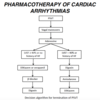Lecture 7: Anti-arrhythmic Integration Flashcards
(24 cards)
Which antiarrhythmic drug classes may lead to long QT syndrome and torsade de pointes arrhythmias?
- Group 1A
- Group 3
- Amiodaron very rarely
List 5 drug classes which may lead to long QT syndrome and torsade de pointes arrhythmias?
- Antipsychotics
- Antiarrhythmics
- Antibiotics
- Antidepressants
- Antihistamines
What is a “triggered activity” in regards to the mechanism of generating Torsades de Pointes arrhythmias?
Depolarizing oscillations in the membrane potential induced by the preceding AP’s

Early afterdepolarizations involved in the induction of Torsades de Pointes arrhythmias are due to impaired function of which ion channel?
Lead to a prolonged period of?
- K+ channels
- Prolonged period of repolarization

To prevent TdPs, what should be monitored and at what level should TdP-inducing drugs not be given?
- Monitor QTc (QT corrected for HR)
- Do not give if QTc is >450 ms
What is the strategy for termination of TdPs if patient is hemodynamically unstable?
Synchronized direct current cardioversion (DCC)
What are 3 strategies/tx’s for patient with TdPs if hemodynamically stable?
- Correction of electrolyte abnormalities, such as hypokalemia and hypomagnesemia
- Magnesium sulfate IV (irrespective of whether pt is hypomagnesemic or not)
- Transvenous temporary pacemaker for overdrive pacing or IV isoproterenol
Flecainide and other class 1C drugs may cause what type of arrhythmias?
Ventricular arrhythmias, such as PVCs, sustained VT and VF
What were the results of the CAST trial in relation to Flecainide?
An excessive mortality or non-fatal cardiac arrest rate was seen in pt’s treated w/ flecainide compared w/ that seen in a placebo-treated group.

Describe the mechanism for digoxin-induced tachyarrhythmias and ectopic rhythms, during which phase and what ions are involved?
- Occur during phase 4 as result of ↑ cytosolic Ca2+ due to Ca2+ overload
- Spontaneous Ca<strong>2</strong>+release from SR activates 3Na+/Ca2+ exchange leading to a net depolarizing current

Describe the mechanism for digoxin-induced bradyarrhythmias and AV blocks?
Central parasympathetic activity and accentuation of vagal effects on the heart
What are 3 treatment options for digoxin-induced arrhythmias?
- Cancel digoxin
- Anti-digoxin antibodies (Digibind, Digifab)
- Potassium supplementation to upper normal levels
In patients with paroxysmal or persistent AF w/ no HF and LVEF ≥ 40% what is the first, second, and third line tx?
- First = CCB or β-blocker
- Second = CCB and digoxin OR β-blocker and digoxin
- Third = Amiodarone

In patients with paroxysmal or persistent AF w/ HF and LVEF < 40% what is the first, second, and third line tx?
- First = β-blocker
- Second = β-blocker and digoxin
- Third = Amiodarone

What are the 5 criteria of the CHADS2 score used as a recommendation for anticoagulation/stroke prevention in pt with atrial fibrillation?
- CHF = 1 point
- HTN = 1 point
- Age ≥ 75 yo = 1 point
- Diabetes mellitus = 1 point
- Stroke or TIA hx = 2 points

Pt’s with a CHADS2 score of ≥ 1 are at moderate-high risk of stroke and should be treated with what?
Oral anticoagulation w/ warfarin or DOAC

In pt with acute Afib where DCC is unfeasible or undesirable and the pt has no HF, LVEF ≥ 40%, which 5 drugs can be used for rhythm control?
- Amiodarone
- Dofetilide
- Flecainide
- Ibutilide
- Propafenone

In pt with acute Afib where DCC is unfeasible or undesirable and the pt HAS HF w/ LVEF <40%, which 3 drugs can be used for rhythm control?
- Amiodarone
- Dofetilide
- Ibutilide

What are 3 tx’s for prevention of paroxysmal supraventricular tachycardia?
- Verapamil
- Digoxin
- Catheter ablation
In pt with paroxysmal supraventricular tachycardia what are the first 2 tx’s used in the algorithm for termination?
- Vagal maneuvers
- Adenosine

In pt with paroxysmal supraventricular tachycardia and LVEF ≥ 40% or no hx of HF what is the first, second, and third line drugs?
- First line = Diltiazem or verapamile
- Second = β-blocker
- Third = Digoxin

In pt with paroxysmal supraventricular tachycardia and LVEF <40% or hx of HF what is the first, second, and third line drugs used?
- First line = digoxin
- Second = Amiodaron
- Third = Diltiazem

What is the first line tx for acute high grade AV block that is symptomatic and what are other options if this tx fails?
- Atropine
- If ineffective, dopamine or epinephrine
- Transvenous cardiac pacing can be initiated
In pt with long-standing AV 2nd or 3rd degree block that have a persistent block or if discontinuining drugs that may be causing block is undesirable what is the next step for tx?
Implantation of permanent pacemaker


